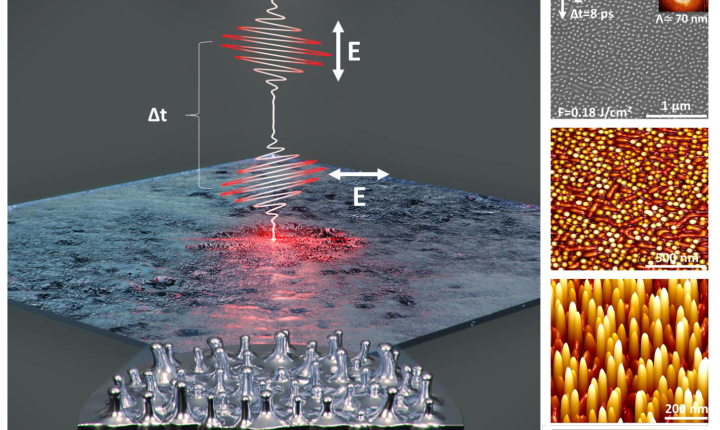Article: Boosted Spontaneous Formation of High-Aspect Ratio Nanopeaks on Ultrafast Laser-Irradiated Ni Surface
Image above: Schematic illustration of the ultrafast laser irradiation process on a Nickel layer, and microscopic view of the generated high peaks' regular and self-organized structure.
An article by the Laboratoire Hubert Curien’s Laser Matter Interaction team has recently been published in Advanced Science, a leading peer-reviewed interdisciplinary journal covering fundamental and applied research in materials science, physics and chemistry, medical and life sciences, as well as engineering.
Biomimicry is often at the origin of the manufacture, at the nanometric scale, of certain surfaces with extraordinary properties. In particular, surfaces characterized by special topographies allow today to reproduce, for example, the extreme hydrophobicity of the lotus leaf's surface, the high adhesive force of a gecko's feet or even the anti-reflection properties of the moth's eyes. The research team has developed an ultra-short laser irradiation process allowing to turn a flat surface into a "forest of nanopeaks" of the highest aspect ratio ever reached. The results of this work open up perspectives for transdisciplinary research, particularly in the field of biology.
The originality of the work carried out by the team lies in the double-pulse experimental configuration of a femtosecond laser, which has permitted to obtain nano-peaks reaching a height of 100 nanometers for a width of 20 nanometers. The temporal shaping of laser beams with polarization control on a nickel monocrystal substrate also allows a regular and densely compact distribution of the created nanostructures on large surfaces.
This method constitutes a significant improvement in current laser surface treatment processes. It lies indeed within a so far unexplored scientific field where the coupling of light and the hydrodynamic effects act in a coherent and synergistic way at the nanometric scale, allowing to create self-organized metastructures. This study also establishes the ultrafast laser technology as a very promising non-contact process capable of rationally and rapidly fabricating complex nanostructures with innovative surface functions.
The work has already caught the attention of the biologists' community, who can see in these results prospects for improving the antibacterial properties of certain materials. Indeed, it has been previously demonstrated that the lethal mechanical forces causing the death of bacterial cells require pointed geometries combined with a very high aspect ratio. This is the case, for example, of the mechano-bactericidal nanostructures of cicada wings, which can inflict critical membrane damage to microorganisms perched onto them, leading to their death.
"The diameter of most viruses being greater than that of our nanopeaks, we can envisage the opening of this work onto a search for possible viricidal properties of these nanostructures", says Anthony Nakhoul, doctoral student in charge of the project and co-author of the article. The team is also considering possible innovative applications of these results in different fields of metaphotonics, such as optical communications, solar energy, optical light guidance or even display and sensor technologies.
Abstract
The capacity to synthesize and design highly intricated nanoscale objects of different sizes, surfaces, and shapes dramatically conditions the development of multifunctional nanomaterials. Ultrafast laser technology holds great promise as a contactless process able to rationally and rapidly manufacture complex nanostructures bringing innovative surface functions. The most critical challenge in controlling the growth of laser-induced structures below the light diffraction limit is the absence of external order associated to the inherent local interaction due to the self-organizing nature of the phenomenon. Here high aspect-ratio nanopatterns driven by near-field surface coupling and architectured by timely-controlled polarization pulse shaping are reported. Electromagnetic coupled with hydrodynamic simulations reveal why this unique optical manipulation allows peaks generation by inhomogeneous local absorption sustained by nanoscale convection. The obtained high aspect-ratio surface nanotopography is expected to prevent bacterial proliferation, and have great potential for catalysis, vacuum to deep UV photonics and sensing.
Check the illustrative video here.
Read the full article here.

